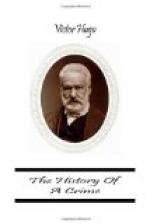An ex-magistrate, General Leflo’s brother-in-law, is conversing on the Pont de la Concorde with some officers before the steps of the Chamber; some policemen come up to him: “You are tampering with the army.” He protests, they throw him into a vehicle, and they take him to the Prefecture of Police. As he arrives there he sees a young man, in a blouse and a cap, passing on the quay, who is being shoved along by three municipal guards with the butt-ends of their muskets. At an opening of the parapet, a guard shouts to him, “Go in there.” The man goes in. Two guards shoot him in the back. He falls. The third guard despatches him with a shot in his ear.
On the 13th the massacres were not yet at an end. On the morning of that day, in the dim light of the dawn, a solitary passer-by, going along the Rue Saint Honore, saw, between two lines of horse-soldiers, three wagons wending their way, heavily loaded. These wagons could be traced by the stains of blood which dripped from them. They came from the Champ de Mars, and were going to the Montmartre Cemetery. They were full of corpses.
[29] It was this same Criscelli, who later on at Vaugirard in the Rue du Trancy, killed by special order of the Prefect of Police a man named Kech, “suspected of plotting the assassination of the Emperor.”
[30] The Marquis Sarrazin de Montferrier, a relative of my eldest brother. I can now mention his name.
CHAPTER VI.
THE CONSULTATIVE COMMITTEE
Al danger being over, all scruples vanished. Prudent and wise people could now give their adherence to the coup d’etat, they allowed their names to be posted up.
Here is the placard:
“FRENCH REPUBLIC.
“In the name of the French People.
“The President of the Republic,
“Wishing, until the reorganization
of the Legislative Body and the
Council of State, to be surrounded by
men who justly possess the esteem
and the confidence of the country,
“Has created a Consultative committee, which is composed of MM.—
“Abbatucci, ex-Councillor of the
Court of Cassation (of the Loiret).
General Achard (of the Moselle).
Andre, Ernest (of the Seine).
Andre (of the Charente).
D’Argout, Governor of the Bank,
ex-Minister.
General Arrighi of Padua (of Corsica).
General de Bar (of the Seine).
General Baraguay-d’Hilliers (of
Doubs).
Barbaroux, ex-Procureur-General (of the
Reunion).
Baroche, ex-Minister of the Interior and
of Foreign Affairs,
Vice-President
of the Committee (of the Charente-Inferieure).
Barret (Ferdinand), ex-Minister (of the
Seine).
Barthe, ex-Minister, first President (of
the Cour de Comptes).
Bataille (of the Haute-Vienne).
Bavoux (Evariste) (of the Seine-et-Marne).
De Beaumont (of the Somme).




